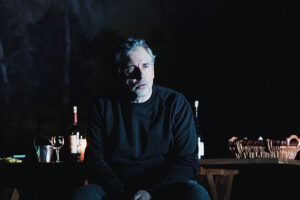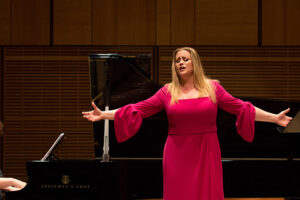

The director conceives the work as therapy for a modern man, disengaged and remote, brought by his wife to a clinic where role play is a tool for healing. He has been assigned the role of Don José and hands over his watch and cellphone as the professionally upbeat team begins to work. He sulks at first, reluctant to put on his nametag or engage with the “soldiers” goofing around with happy-face pop guns and lip-syncing the children’s chorus music.
Gradually he is drawn into the playacting, and the audience—enlightened, amused, and anxious—experiences the work through this lens. When the patient is forced to engage with this wife, cast as Micaela, he blurts out “Parle-moi de ma mère” (he’s in therapy after all), and improvises a repetitious duet that he doesn’t really believe in. It makes perfect sense. As the work unfolds, Tcherniakov’s attention to detail brings revelation after revelation, putting familiar lines into a new emotional framework. The music-hall smugglers’ quintet and the “Bel officier” passage make perfect vaudeville routines, with phony weapons and shtick, to cheer up the gloomy patient.
When the therapist playing Zuniga is hurt, the decision is made to discontinue the therapy, the patient having begun to release his emotional blocks. He insists on staying, however, and the atmosphere darkens. The entr’acte music is piped in to calm him down (harp and flute never sounded more appropriately trite). The Carmen therapist, who missed her first entrance and began awkwardly, has become more adept and also more frightened. Her discomfort is obvious in the card reading, and she too wants out.
By the final scene the suspense is excruciating—how far is she going with this?—and we see the mounting violence and the expected stabbing and José’s wailing, without knowing what is real and what is play. But Carmen bounces up and the team returns with balloons and champagne to celebrate the great catharsis and cure. The patient, however, has broken down completely, a sobbing and ruined wreck.
As the patient and Don José, Michael Fabiano’s traversal of emotions (ambivalence, confusion, jealousy, embarrassment) provided the perfect psychological link to the audience. Singly boldly, the tenor’s engagement with the concept was supreme and seemed to drawn him to even higher levels of musical expression. The Flower Song was delivered powerfully and convincingly, with dark timbre and massive high notes, then shrugged off with a “whatever,” but as the patient’s feelings are released he is horrified by their violence, and Fabiano met each moment with full commitment and pedal-to-the-metal singing.
For Stéphanie d’Oustrac, the unusual acting challenges must have been a welcome change from the usual characterization (although she rattled the castanets deftly), and the constraints of her professional role and the requirement to follow the script brought extra depth to every musical number. With supple and even sound, beautiful, narrow chest voice, and just the right force above the staff, her commitment and believability matched Fabiano’s completely, and they met every moment of the final scene with terrifying truth.
Elsa Dreisig was the perfect Micaëla, with her golden, opulent soprano and excellent musicianship, but Michael Todd Simpson was a pale and often quivery Escamillo. Gabrielle Philipnet’s Frasquita was also unsteady and often shrill, but Virginie Verrez provided luxury casting as a rich-voiced, powerful Mercédès.
The Orchestre de Paris brought detail, color, and verve to the score under Pablo Heras-Casado’s alert baton, and the Choeur Aedes did their director, Mathieu Romano, proud, with excellent singing and engaging individual characterizations. Guillaume Andrieux and Mathias Vidal were the sprightly Dancaïre and Remendado, while Christian Helmer’s Zuniga and Pierre Doyen’s Moralès, along with Pierre Grammont’s Head Administrator, whose invented lines substituted for the original spoken dialog, contributed powerfully to the sanatorium atmosphere.

Michael Levine’s set was a stark white paper box. Will Duke’s video projections moved from the bucolic English countryside where Tom and Ann fall in love to a glittery London penthouse where Tom, having inherited a fortune, falls into naughty ways. Various characters punch through the walls, demonstrating the flimsiness of this world as well as their willingness to leave a mark on it. First to tear through is Nick Shadow, who projects his voice and his shadow all over the set to prove that devilish temptation is everywhere.
Later Baba the Turk, the circus performer the corrupted Tom is persuaded to marry, bursts merrily through the paper door of her white stretch limo. And when the couple set up house, bizarre art objects crash through the ceiling and walls of their tacky gilded salon. Paul Anderson’s lighting and choreography by Leah Hausman add to the energy of this visually engaging, quick moving production.
Eivind Gullberg Jensen was a last-minute substitute for conductor Daniel Harding, who withdrew after a wrist injury. The Orchestre de Paris brought clarity to Stravinsky’s classicist score, though Jensen was often unable to adjust to the singers’ speedy declamation. As Ann Trulove, Julia Bullock displayed heft in the lower range of her clear and clean soprano and a lovely spaciousness on top. Her steady determination to rescue Tom was moving, and looking like a schoolgirl in her backpack, she innocently dropped a coin for the solo trumpet busking in a seedy-looking underpass.
She might have brought more brilliance to the cavatina “I go to him” in the bel canto parody scena that ends Act One, but when Ann at last visits the deranged Tom, Bullock brought spellbinding intensity to her gently hushed lullaby, “Gently, little boat, / Across the ocean float.”
Paul Appleby was ideally cast in the title role, moving from country boy with ambition—he refers to his future father-in-law as “an old fool”—to hesitant plaything of the lusty madam, Mother Goose, to bored playboy with lovers cycling in and out of his bed. It was solidly sung with attractive clarity, as expected, but in the graveyard scene, when Tom plays a life-or-death game of cards, Appleby’s desperation was profound and affecting. Tom’s demise, thrashing helplessly in a psych ward, was touching in its simplicity and sincerity.
Kyle Ketelsen’s slender and lustrous voice (along with impeccable diction) matched an appealingly lithe physical presentation as Nick Shadow, a corrupting influence it would be hard to resist. Alan Oke, more vocally appealing here than as Caliban in the Met’s production of Thomas Adès’ Tempest, resisted caricature as the Auctioneer, tastefully exhibiting Tom and Baba’s possessions to art-world snobs (the best of Christina Cunningham’s costumes, and superbly detailed by the English Voices, under Tim Brown’s direction).
Hilary Summers used her tall physique, deep voice, and easy-going appeal to command the stage as the brothel madam Mother Goose, stripping to black garters and corset to tempt and taunt Tom, and finally collapsing on top of him for his initiation into a world of depravity and forgetfulness. David Pittsinger, looking the man of the manor in Wellies and country cap, brought handsome tone and sturdy resonance to the role of Ann’s father.
The only casting mistake was using a countertenor as the bearded lady Baba the Turk, a role created by mezzo-soprano Jennie Tourel. Although Baba is supposed to hide her facial hair from Tom until their wedding night, this creature’s wild looks were plastered everywhere in google-images wallpaper. Although Andrew Watts looked hilarious in orange wig and beard, he screamed high notes, belted low notes, and fudged much in between. Since not one word of his text could be understood, many missed the point that Tom eventually tires of Baba’s pointless yakking.
Philippe Boesmans’ new Pinocchio could use some trimming, but the vocal writing is effective and skillful, with a hauntingly beautiful score realized by Klangforum Wien under the baton of Emilio Pomarico. Joël Pommerat’s dark and dreamy production features tour-de-force lighting and sets by Éric Soyer, costumes by Isabelle Deffin, and video by Renaud Rubiano. With his solid and elegant singing, baritone Stéphane Degout guides the listener through a succession of short scenes featuring the obnoxious, soon-to-learn-his-lesson puppet, excellent realized by Chloé Briot.
Marie-Eve Munger sings the tour de force role of the fairy, towering a few stories above the ground, while Vincent Le Texier, Yann Beuron and Julie Boulianne take several roles. Onstage accordion, sax, and gypsy violin add musical and theatrical color.
Photos: Pascal Victor/ArtComPress























Comments